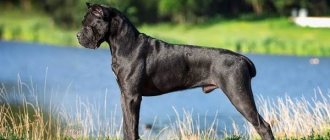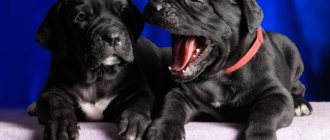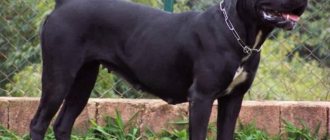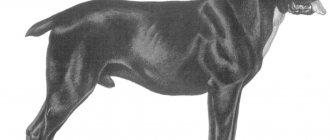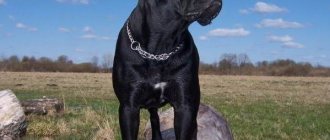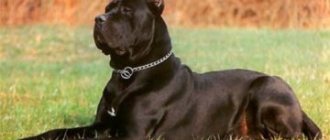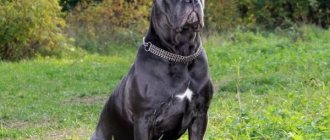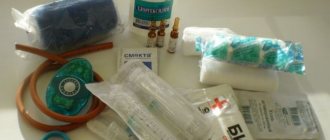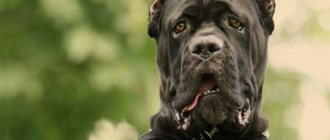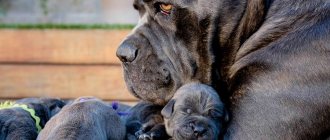- Description of the breed
- Photo
- Nurseries
- Lifespan: 9-11 years
- Weight: males 45-50 kg, females 40-45 kg
- Height (height at withers): males 64-68 cm, females 60-64 cm
- Puppy price: pet class – 20-25, breed class – 30-40, show class – 50 thousand rubles and above
The Cane Corso is an ancient Italian breed with an impressive appearance. They are very smart and loyal, making excellent home guards.
Story
They say that the first ancestors of the Cane Corso existed back in the Roman Empire, during its heyday. Huge and menacing in appearance, they took part in gladiatorial battles and sometimes served as bloodhounds, helping to find runaway slaves. In the Middle Ages they were brought to Europe and became hunters, enjoying popularity among the nobility.
Closer to modern times, already in the 19th century they lived with ordinary people, looked after children and herds, and sometimes even replaced horses in plowing.
In the first half of the 20th century, they almost became extinct: wars and famine did not allow feeding such large animals.
In the second half, when the breed was on the verge of extinction, an enthusiast was found who took up its revival. His name was Giovanni Nizolli. He looked for representatives, crossed them with each other, and thanks to this, already in 1966 the first breed standard was adopted.
The name literally translates as “yard dog,” and in Italy they still say about a brave person “brave as a corso” instead of “brave as a lion.”
First 4 years
The weight of an adult dog already reaches 45 kg for females and 55 kg for males.
As a rule, the first mating is carried out during this period. After it, the males again try to take leadership positions, but this time not within the family circle, but among other dogs. Thanks to their strength, Cane Corsos can cause great harm to other pets with whom they previously played during a walk. Under no circumstances should a dog be allowed to assert itself in this way.
Similar article: The most common and rare Cane Corso colors
The dog’s character can be adjusted up to three years of age, but the older he gets, the more difficult it is to do this.
Standard
Adopted in 1966, the standard has been revised several times and is now in effect in a revision dated 2010. According to it, a true champion should have the following characteristics (FCI-Standard N° 343):
- Height up to 64 cm, weight up to 50 kg. Female babies grow slower than male babies, but by adulthood they reach approximately the same height. The animal is muscular, lean, and not prone to excess weight.
- The skull is wide, the head is large, the transition from the forehead to the nose is noticeably pronounced, the cheekbones are clear. The muzzle is square, symmetrical and flat.
- The nose is large, with wide nostrils, upturned. Definitely black. Gray is allowed, but only if there is a gray mask on the face.
- The lips are fleshy, do not fit tightly to the teeth, the upper one hangs over the lower one, and forms pronounced drooping jowls at the corners.
- The eyes are oval, medium in size, slightly convex. The ideal color is dark brown, but light brown, amber, and even gray are acceptable if the dog itself is gray. But blueness is unacceptable.
- The ears are set high and wide apart, drooping and covered with velvety fur. Previously, they were cropped, but now the standard does not allow this: the shape must be natural.
- The tail is long, not pubescent, becoming thinner towards the end. Its fur is short.
- The neck is powerful, thick and dry, without dewlap.
- The body is elongated, the back is wide, the loin is short, the chest is wide and developed.
- The legs are straight, the wrist is strong and flexible.
It moves expansively and easily, and is distinguished by endurance and strength. Good, jumps high, moves mainly at a powerful trot.
Coat and color
The coat is short, shiny, without undercoat. The Cane Corso breed sheds little by little all year round, the hairs are sharp and unpleasant to the touch. There are several acceptable colors:
- Black. Without impurities, without tan. The nose must be in tone, the eyes are dark. Other breeds with black color.
- Grey. Light, delicate color, gray eyes and gray nose are allowed.
- Brindle. Brown with dark tiger-like stripes.
- Gray brindle. Gray corso with stripes.
- Redhead with a mask. A black or gray mask of regular outline, tightly fitting to the eyes and not extending beyond the muzzle, is allowed.
White spots on the chest, on the tips of the paws and on the bridge of the nose are acceptable. There are no pure white Corsos; spotted colors are not considered acceptable according to the standard.
Lifespan
Cane Corsos are large dogs, so their lifespan seems pitifully short to most owners: on average 10-11 years. The oldest representative lived to be 14 years old, but this was an extraordinary case. However, 10-11 years is considered quite a decent period for a large breed - Newfoundlands and Dobermans, for example, live on average 8 years.
Table of height and weight by month
Puppies grow quickly and reach full adult strength by two years. You can see it more clearly in the table:
| Age, month | Height, cm | Weight, kg | ||
| For a male | For the bitch | For a male | For the bitch | |
| 2 | 44 | 32 | 9 | 8,8 |
| 3 | 49 | 42 | 13,5 | 12,5 |
| 4 | 56 | 47 | 16,5 | 18 |
| 5 | 62 | 55 | 24,5 | 22,5 |
| 6 | 64 | 57 | 31,5 | 28 |
| 7 | 65 | 58 | 37,5 | 33,5 |
| 8 | 65,5 | 59 | 40 | 36 |
| 9 | 66 | 59,5 | 42 | 38 |
| 10 | 66 | 60 | 44 | 40 |
| 11 | 67 | 61 | 45,5 | 41,5 |
| 12 | 67 | 63 | 47,5 | 43 |
| 24 | 68 | 64 | 50 | 45 |
Of course, the values are only approximate. Deviations of 5 cm in any direction and 5 kg in any direction remain within the normal range.
Video “Features of the Cane Corso breed”
From this video you will learn about the character of a Cane Corso dog and how to care for a dog.
Recommended Posts
Everything about the Cane Corso or Italian Mastiff breed, pros and cons, photos
Tips from a dog handler on raising and training Cane Corso
Table of toy terrier weight and height by month
Standard and docking of ears and tail in the Cane Corso breed
Husky weight standard and sizes by month
What can and cannot be fed to a Cane Corso dog?
Character
Most often, the character of an animal can be judged by the task for which it was bred. It’s difficult in this regard with Cane Corso: over their long history, they have managed to be fighting dogs, shepherds, security guards, bodyguards, and just friends. Therefore, their features do not have a clear connection to any one purpose.
- devotion. The Cane Corso is one of those breeds that choose one owner and remain loyal for life. Of course, they will love the owner’s children, their partner, their elderly parents, and even their beloved canary, but they will all forever remain in second place. This does not affect behavior; the dog is equally obedient to all family members. But it affects the feelings: if the owner leaves, the Corso will be sad and even increased attention from other familiar people will not be a consolation. That’s why dogs have a hard time coping with a change of owner. Sometimes it happens that the new owner cannot take the place of the old one in the dog’s heart.
- equilibrium. If a large animal flinches at every rustle, is nervous and easily excitable, it will become dangerous. That’s why Corsos are quite phlegmatic and cope well with stress. Their peace of mind is not shaken by loud arguments, moving, children trying to play with their tail, or sudden loud noises. Only disapproval or absence of the owner can seriously affect the dog’s condition.
- security qualities. Even an untrained Corso exhibits the habits of a guard. He is suspicious of strangers, does not allow strangers near the owner’s children and property if the owner himself is not around, and does not like familiarity. There is no prohibition against aggression towards humans in his genes, therefore, if his charges are in danger, the dog will protect them at all costs. It’s not scary to let the children go out with him.
- caring. These are echoes of the times when Corso lived in peasant families, looked after herds and looked after children. Since then, they get along well with other dogs and small animals. They feel a reverent love for children and are happy to look after the kids, play with them and have fun.
These are smart, calm dogs who obey their loved one not out of fear, but out of conscience, and are surprisingly flexible for their size. All that is required from the owner is to explain the rules to the Corso, show what needs to be feared in the world around him, and what is harmless, and not spoil anything in the psyche.
Advantages and disadvantages
The advantages are the following:
- They are excellent guards and defenders. With them you don’t have to worry about your home, and when you go out for a walk at night, you don’t have to worry about meeting bad people.
- They are very smart and flexible. Even with teenagers there are usually no problems.
- They are happy to benefit. Carry shopping bags? Keep an eye on small children? Drive away a stranger? Corso will be happy to do this.
- They lack hunting instincts. They won’t chase cats, try to grab every squirrel in the park and be distracted by unfamiliar smells. They get along easily with other animals.
There is little that can confuse or frighten them - their psyche is stable and able to cope with stress, especially if people are ready to help a little.
But everything is never perfect, which means there are also disadvantages:
- The dog will need adequate training. He must distinguish where the owner is being attacked and where they just want to hug him, he must not be afraid of the city and must neutralize the stranger, and not try to bite him to death. To do this, he will have to take courses where he will be trained as a defender. And even earlier, you will need to be able to explain to the baby what is possible, what is not, when a person is happy and when he is not. And this will require not only time, but also strength and patience.
- Will need care. Corsos shed constantly, so you will have to devote time to caring for the coat. They also eat a lot, simply because of their size, and the food must be of high quality.
- You will need attention and love. This is not a dog that can live in a yard or mind its own business most of the time. She needs to be close, interact, play, or at least lie at her feet, enjoying the presence of her person.
- Long, pleasant walks are needed. You need to run, play and exercise with the animal so that it has time to get exhausted and when it comes home it just falls asleep. Therefore, it is not suitable for the sick, the elderly and not very active people.
Due to the structure of the muzzle, the Corso constantly salivates - this is typical for flat-faced mastiffs in general. The fur also gives off a faint dog smell, and individual hairs constantly fall around. Therefore, they are not suitable for people who like sterile cleanliness to reign in their home.
Learning ability
The Cane Corso is a stubborn and cunning dog. During training, she tries with all her might to ignore her owner’s commands, especially in puppyhood.
A beginner needs to make an appointment with a professional dog handler - it is impossible to achieve obedience on your own without experience.
If you show persistence and methodically repeat commands on every walk and ensure their implementation, training a Cane Corso will not be difficult - it will master the general training course and protective service.
Start raising a puppy by establishing clear rules of behavior in the apartment. If the puppy does unwanted actions - climbs on the bed or chews slippers - scold him. Encourage positive moments. A smart Corso will quickly understand what they want from him.
How to care and maintain
For a dog to feel good, it needs to be properly looked after.
- provide a suitable place to rest. He will go there when he gets tired of society, he will hide his most favorite toys there and will go there on the command “place”. Usually they try to choose a secluded, quiet corner, which they usually rarely walk past - in each house such a place is individual. So that the puppy immediately understands where he should sleep and does not worry, it is recommended to place a bed in the chosen place, and on it - something from the breeder’s house that smells like his mother, sisters and brothers.
- comb. Italian Mastiffs are short-haired, but they shed constantly, and their fur is sharp and easily injures soft human skin. Therefore, once a week, the dog is thoroughly combed with a soft massage brush, and then the hairs that have attacked it are swept away into the trash bin.
- take care of claws and teeth. Nails are trimmed once every two weeks, or less often if they do not have time to grow back. Teeth are brushed with a soft brush and a special paste that tastes like bacon or chicken. Since few animals like it when people grab their paws or try to climb into their mouths, you need to accustom your puppy to procedures from a very young age.
- take care of your eyes and ears. The eyes are a weak spot, they often water and become easily inflamed, so every morning they are wiped with a cotton pad, removing discharge, and every evening they are checked for redness. The ears also need to be examined every day and excess wax removed from them.
- take care of your jowls. Due to the structure of the muzzle, the Corso constantly secretes saliva, and once a day the shaven is wiped with a cloth, wiping off sticky marks from it.
The dog needs to be washed as it becomes dirty: usually, after each walk, the paws are wiped, and the whole body is washed only after a full bath in a puddle.
Walk twice a day, morning and evening, for an hour and a half, and actively, so that you have time to run around and get tired. On weekends, it is advisable to travel outside the city, to a place where you can let a large animal off its leash without fear that it will scare someone.
The main rule is that the more energy a pet spends on a walk, the less desire it has to make a mess in the house.
Two to seven weeks
During this period, the dog’s character is formed and he is ready for simple training. It is already clear who will have the makings of a leader. Depending on this, the method of training for a given period is selected. It is recommended to “push” inactive children to move, and to simply observe and make sure that active children do not harm themselves or spoil valuable things. Under no circumstances should you punish them, otherwise they will grow up fearful or aggressive.
It is important that puppies can have contact with people, then they will treat them normally, and strangers in the house will not cause aggression or fear in the dog.
What to feed and how much
There are two feeding options - either dry food or natural food.
Since there is a breed tendency to allergies, it is usually recommended to feed them dry food: there is less chance of making a mistake and giving something that will cause a reaction. Recommended: First Choice, Purina, Royal Canin, Akana. The dosages are indicated on the packaging, as well as the purpose: a puppy is fed with food for babies, an adult dog with food for large breeds, a pregnant bitch with food with a high content of vitamins and nutrients.
It is important not to mix food with natural food, not to overfeed and change food if it gives your pet indigestion. This happens: even the highest quality, best product cannot suit everyone equally well.
Natural food is less recommended, but if the owner likes to cook or has a principled position, you can try to create a diet that is suitable for a particular animal. A typical diet includes lean meat, cereals, boiled vegetables that do not cause gas, dried bread, pieces of fruit and dried offal as treats, and fermented milk products as a source of calcium. A little vegetable oil is added to the porridge, the meat is sometimes replaced with fish, and once a week the dog is offered a boiled egg.
During the period when the diet is just being introduced, it is important to observe the body's reactions: any change in stool consistency or behavior may be the result of a lack of nutrients.
The recommended food intake is 3% of the dog's total weight per day. That is, an adult mastiff weighing 50 kg should eat 1.5 kg of food. Moreover, everyone’s body is different, and the figure may fluctuate a little: you need to monitor the dog’s weight and well-being.
Vaccinations
Mother's milk, which puppies are fed in the first weeks after birth, provides their immunity. When the lactation period ends, the babies' protection from infections and diseases disappears. It is replaced by immunity independently developed by the puppies.
| Age | Graft |
| 6-8 weeks | Vaccine against enteritis and hepatitis |
| 8-10 weeks | Revaccination + vaccinations against parvovirus, adenovirus and parainfluenza |
| 2.5-3 months | Vaccination against plague |
| 6-8 months | Rabies vaccine (if a plague vaccination was previously given, rabies vaccination is carried out only at 8 months) |
| 7-8 months | Repeated vaccination against plague |
| 1 year | Vaccination against leptospirosis |
| In the future, vaccinations are repeated annually at the same time. | |
Popular drugs for vaccination are Eurican, Duramune, Nobivac.
Vaccination is not a method of treating a disease, but its causative agent, so it is important that the puppy is absolutely healthy at the time of vaccination.
Breed diseases
The description makes it clear that this is a breed with a long, complex history. And like any other with a long, complex history, she carries with her a burden of genetic errors and defects that affect her health. Of course, breeders do tests and carefully select dogs without bad heredity, but still there is a predisposition to certain diseases:
- Hip dysplasia. Often found, and not only in large dogs. It occurs suddenly - lameness, severe pain, the dog complains and does not step on its paw. Treatment is long and difficult, so reputable breeders either provide test results indicating that the puppy does not have a tendency to dysplasia, or do such tests at the request of the future owners.
- Allergy. It most often manifests itself as allergic reactions to food - redness, rash, itching, and sometimes breathing problems. All representatives have a tendency to it, so owners are advised to consult with a veterinarian in advance and choose the appropriate food.
- Epilepsy. Epileptic seizures negatively affect the dog’s nervous system, and any chaotic flickering of lights can provoke them. Epilepsy cannot be treated, it can only be suppressed with medication, which is why animals with it are not sold for sale.
- Thyroid diseases. They make the pet irritable, nervous and disobedient, causing them to gain weight sharply or, on the contrary, lose it. They are treated with constant use of hormones, which is expensive, and such animals are not allowed for sale.
- Eye diseases. Most often - inversion or inversion of the eyelid. It can be treated surgically, but is still inherited, which is why representatives with it are sold as a pet class, not available for reproduction.
The list is far from the most impressive - many suffer from a much larger number of diseases.
The main task of a person is to choose a puppy that will be healthy in all respects.
Purchase
You can purchase a Cane Corso puppy from both private breeders and specialized nurseries. By choosing option 2, you can minimize the risk of buying a sick, non-purebred pet or one that does not meet the breed standard.
The most popular nurseries:
- Della Valle Dei Tigri, Saratov;
- Celebrity Starlet, Bryansk;
- “Kani Miglori”, Nizhny Novgorod;
- "Corso Granat", St. Petersburg;
- Blow Century UA, Moscow;
- Deo Volente, Moscow;
- Grand Golden Guild, Grodno, Belarus;
- Velvet Black, Minsk, Belarus;
- “Star Treasure”, Minsk, Belarus;
- Be Come The Star Dragon, Odessa, Ukraine;
- Golden Moloss, Kiev, Ukraine;
- Blow Century UA, Kiev, Ukraine.
The cost of a puppy varies depending on its age, health, pedigree, parents' titles and class. So, a pet-class representative can be bought for 13-15 thousand rubles, a breed-class dog will cost 20-25 thousand rubles, and for a show-class puppy you need to pay 35-60 thousand rubles.
Training and education
From the very characteristics of the Cane Corso breed, it follows that these dogs are highly trainable, especially when the owner trains them. The basic rules are simple:
- The best encouragement for them is praise. Hunting dogs happily work for food. Loyal to their owners, Corsos are involved with the same enthusiasm in any activity in which people participate and for which they will be praised. Positive reinforcement with stroking, patting, and kind words is better for them than any other.
- You shouldn’t scold them too much if something doesn’t work out. An animal usually does something wrong not out of malice, but simply because it does not understand what a person wants. Therefore, any negative reinforcement must have a purpose: to convey a message, to show what exactly is wrong. This means that physical pressure, shouting or a stern tone are ineffective.
- They know how to imitate other dogs and learn from them. Therefore, learn commands well on the site, with other dog lovers. A trained dog does it - the Corso repeats, and everyone is happy. All a person can do is correct mistakes and give advice.
Otherwise, the principles of training are no different from the principles of training any other breed - constancy, consistency, practicality.
Consistency means that any rule must always apply, from the moment the puppy crosses the threshold. Even if at two months he is still very small, wrinkled and cute, it doesn’t matter. He will remember everything he learns now and will do exactly the same thing when he grows up. Therefore, you should not allow him to climb into bed, jump into people’s arms, or bite in play - then it will be very difficult to wean an adult pet.
Consistency means that the system of rules should be harmonious and uniform. You can't climb on the bed, okay. But you can’t climb on the sofa, or on the chair, or on the armchair. And in the morning, and during the day, and after a walk, and at night. And with the owner himself, and with children, and when there is no one at home - it’s also impossible. Only such rules will be clear to the dog: it must know why it is praised and what it is scolded for, and not get confused, which will inevitably happen if it is scolded and praised for the same thing at different moments.
Practicality means that any human action must carry the correct educational message. It already carries some kind of message - it’s just that many people don’t think about it in the process.
For example, a small puppy bites its owner in a game. At the age of three months, he just tries everything by the tooth and behaves with a person the same way he behaved with his brothers and sisters. If the owner continues the game, thinking that it was an accident or writing it off as normal children's pranks, the puppy will think that everything is normal, that it is okay to play like this. And then you will be very surprised if you start weaning it off.
Or the owner wants to reward the baby and puts a treat on the floor in front of him. After a few times, the puppy understands that the reward is placed on the floor, and begins to consider everything on the floor as its rightful prey: meat that has fallen from the table, the corpse of a pigeon lying on the asphalt in the street. And, again, he will be surprised and indignant if they try to take something away from him from the floor.
In parenting, a person must show responsibility and common sense, must think about his actions and clearly understand what messages he puts into the puppy’s head. And at six months he must take the mature teenager to service courses, where he will be taught how to properly protect people.
If something didn’t work out in the upbringing, and the pet persists in some behavior that the owners don’t like, you need to go to a dog handler: he will help you find out what the mistake was and show you how to correct it. As a last resort, you will have to go to a zoopsychologist.
In general, the training process is a fun and exciting activity.
4–6 months
At 4 months, the dog has already reached a large size (height at the withers is 47 or 56 cm, depending on gender) and outwardly looks like an adult, but in behavior it is still a puppy who frolics and plays a lot.
Similar article: Everything about the Cane Corso or Italian Mastiff breed, pros and cons, photos
Now the baby is not only trying to growl, but is also trying to establish a hierarchy in the family. It is very important to earn the dog’s respect and show that all family members, including children, must be obeyed. Otherwise, the dog will become uncontrollable and will feel like the mistress of the house.
Once you've learned the basic commands, you can move on to more complex ones. Training should be systematic and interesting for the pet.
We recommend the article: Tips from a dog handler on raising and training Cane Corso
Now puberty is starting. Bitches tolerate this period normally, but males develop a strong desire: they can throw themselves at the owner’s leg or at other dogs. But you don’t need to punish your pets too much for this, especially if you plan to use a male dog for breeding.
Top nicknames
They usually try to name their pets so that the nickname is reminiscent of the Roman origin of the breed. Moreover, they try to choose not just an Italian name or a Latin word, but something short, succinct and simple, so that it is easier for the animal to remember and for the person to use.
For boys: Adri, Albert, Amato, Vitale, Dino, Gino, Italo, Luca, Marco, Mario, Luke, Cesare, El, Yary, Uli, Chris, Tamal, Ares, Zeus.
For girls: Adele, Adona, Alba, Alda, Berta, Bianca, Cinta, Dora, Elda, Hera, Erica, Febo.
The list contains names of gods and goddesses, as well as Italian names denoting beauty, happiness and joy.
Color options when mating with different coat colors
Let's now take a closer look at what color options are possible when breeding dogs with different coat colors.
Absolutely black parents can produce not only black puppies, but also blue (a shade of gray), brindle, blue-brindle with a blue mask, red with a black mask and fawn with a blue mask.
Also, black parents may have a gray baby with black eyelids, lips and a gray nose. The black color is not caused by any one gene, but by the combination Ay-BD-Em-K-. You can see for yourself how much space Mother Nature has for creativity.
If you breed brindles, they will also give a variety of offspring, but there will be no black babies.
At the same time, if one of the parents has a solid color, but has at least one tiny “tiger”, he can no longer pass on the gene necessary for the formation of black color. In brindle dogs, the puppies will be brindle with a black mask, red with a black mask, blue brindle with a blue mask, or fawn with a blue mask.
If blue brindle and blue dogs are bred, then all the offspring will be light colors: the same colors as the mother and father, or light red with a blue mask, formentino.
Parents who are red with black or blue masks will produce red puppies with a black mask or fawn with a blue mask.
If you study the genetics of colors in detail, you can control the color of the coat of future babies.
Choosing a puppy
Choosing a puppy is a troublesome, but enjoyable task. You need to approach it wisely and consistently:
- Find a breeder. To do this, you should use the Internet, go to breed forums and read reviews there. A good breeder has a lot of them, there are mentions of the dogs on the Internet, it’s easy to find satisfied owners and mentions of which of them won which competitions. You can search by the name of the breeder, by the name of the nursery, by the names of the pets.
- Meet the breeder and animals. An adequate breeder will offer to get to know the puppy’s parents and himself - or wait until the bitch brings a litter and get acquainted then. It is important to pay attention to the conditions of detention and how the dogs look. Are they friendly, are they cheerful, do they have shiny fur, are they aggressive?
- Choose a specific puppy. Get acquainted with the documents - and he must have a pedigree, vaccination card and passport - get to know the baby himself. He must be healthy, have clean ears and a soft tummy, and be active and interested in exploring new people.
If you can’t meet in person, you can only rely on reviews and order your baby online. Most nurseries are ready to send a new family member by train or plane to anywhere in the country.
And if domestic nurseries are not satisfactory, you can always turn to foreign ones.
Baby's health
Taking care of your puppy's health is your first responsibility.
It consists of the following:
- Choose a reliable and qualified veterinarian to whom you will take your dog for examinations and procedures. Read reviews, ask the breeder for recommendations.
- Vaccinations . Timely, in accordance with the scheme (formed by the veterinarian). Afterwards - quarantine for 10-14 days.
- Prevention of parasites . It is carried out once every 3 months and 3 weeks before vaccination.
- Prevention of bites . In the warm season, drops against fleas, mosquitoes and ticks once a month.
So, if you are determined to adopt an Italian Mastiff puppy, you will need to be prepared for some challenges, as well as follow the training and care guidelines. If everything is done correctly, a well-mannered and devoted dog will become a reliable friend and protector for many years.
